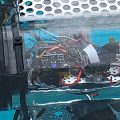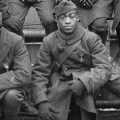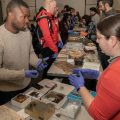National Native American Veterans Memorial opens to the public
Honoring the Military Service of Native Americans
We are a nation of patriots who believe in the United States, its democracy, and our responsibility to preserve it for future generations. We acknowledge those who have served in the armed forces as the greatest patriots of all. Though we celebrate those who dedicate themselves to defending our nation, many Americans are unaware of the exceptional service performed by American Indian, Native Hawaiian, and Alaska Native veterans.
The National Museum of the American Indian opens the new National Native American Veterans Memorial today, Nov. 11. The moment was marked with a short virtual message to honor the service and sacrifice of Native veterans and their families.
“The National Native American Veterans Memorial will serve as a reminder to the nation and the world of the service and sacrifice of Native American, Alaska Native and Native Hawaiian veterans,” said Kevin Gover, director of the museum. “Native Americans have always answered the call to serve, and this memorial is a fitting tribute to their patriotism and deep commitment to this country.”
The memorial, which sits on the grounds of the museum, was commissioned by Congress to give “all Americans the opportunity to learn of the proud and courageous tradition of service of Native Americans in the Armed Forces of the United States.” Native Americans have served in every major military conflict in the U.S. since the Revolutionary War. This will be the first national landmark in Washington, D.C., to focus on the contributions of American Indians, Alaska Natives and Native Hawaiians who have served in the military.
The museum planned to host a dedication ceremony and veterans’ procession to mark the memorial’s completion but postponed those events due to current health and safety guidelines. The museum will reschedule both events when it is safe to do so.
The Design
An elevated stainless-steel circle balanced on an intricately carved stone drum, the design of the National Native American Veterans Memorial is simple and powerful, timeless and inclusive. The design incorporates water for sacred ceremonies, benches for gathering and reflection, and four lances where veterans, family members, tribal leaders, and others can tie cloths for prayers and healing. The memorial creates an interactive yet intimate space for gathering, remembrance, reflection, and healing. It welcomes and honors Native American veterans and their families, and educates the public about their extraordinary contributions.
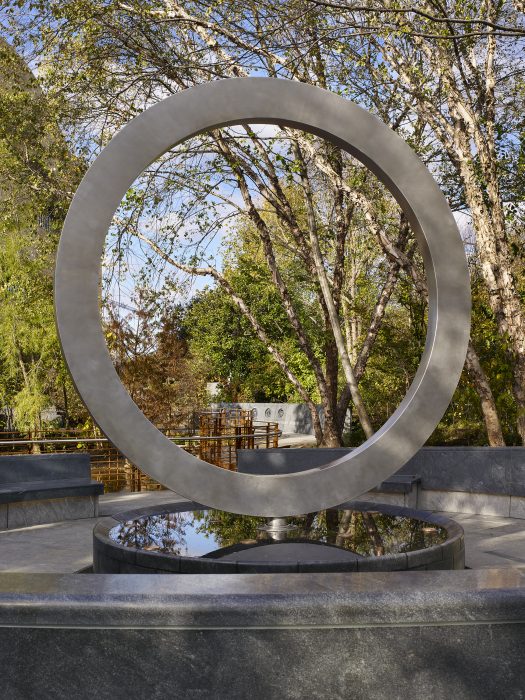
National Native American Veterans Memorial designe4d by Harvey Pratt. Photo by Alan Karchmer for NMAI
The Designer
The memorial design is by Harvey Pratt (Cheyenne and Arapaho Tribes of Oklahoma), a multimedia artist, retired forensic artist and Marine Corps Vietnam veteran. The design features an elevated stainless steel circle resting on a carved stone drum. It also incorporates water for sacred ceremonies, benches for gatherings and four lances where veterans, family members, tribal leaders and others can tie cloths for prayers and healing.
A distinguished group of Native and non-Native jurors unanimously selected the design concept Warriors’ Circle of Honor by Pratt from among more than 120 submissions. Pratt is a self-taught artist whose works include themes of Native American history and tradition and the Cheyenne people. Born in El Reno, Oklahoma, Pratt credits his parents and teachers for encouraging his artistic pursuits and respect for veterans. A veteran himself, Pratt served in Vietnam from 1962 to 1965 as a U.S. Marine in Air Rescue and Security stationed at Da Nang Air Base. He is recognized by the Cheyenne People as an outstanding Southern Cheyenne, and was inducted as a traditional Peace Chief—the Cheyenne Nation’s highest honor.
Major support for the National Native American Veterans Memorial has been provided by the Cheyenne and Arapaho Tribes; Chickasaw Nation; Margaret A. Cargill Philanthropies; Poarch Band of Creek Indians; San Manuel Band of Mission Indians; and Shakopee Mdewakanton Sioux Community. The memorial has also been widely supported by tribal governments and tribal veterans organizations. More than 85 tribes, individuals, corporations and other organizations have contributed to the memorial.
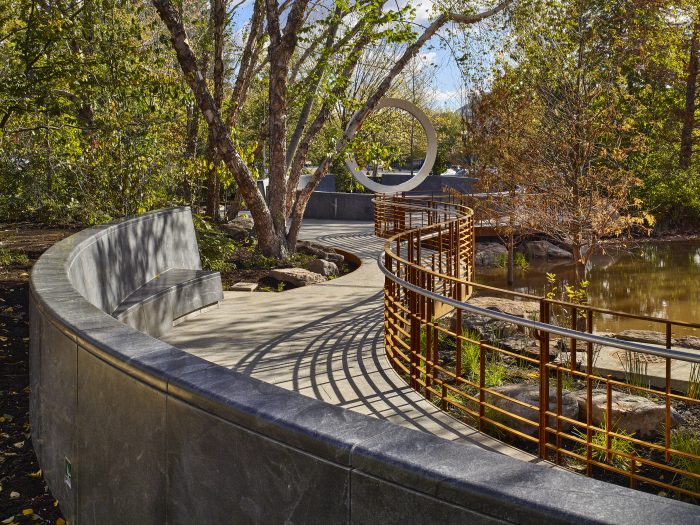
National Native American Veterans Memorial. Photo by Alan Karchmer for NMAI
Why We Serve: Native Americans in the United States Armed Forces Book and Exhibition
To coincide with the completion of the National Native American Veterans Memorial, the museum has published Why We Serve: Native Americans in the United States Armed Forces, a 240-page book that commemorates the history of Native American military service. Native Americans serve in the military at one of the highest rates of any ethnic group, and the book explores the many reasons why—from love of home to the expression of warrior traditions.
The book is co-authored by Alexandra Harris and Mark Hirsch, senior editor and historian, respectively, at the National Museum of the American Indian. Other contributors include
- Sen. Ben Nighthorse Campbell (Northern Cheyenne), Rep. Deb Haaland (Pueblo of Laguna)
- Rep. Markwayne Mullin (Cherokee Nation),
- Kevin Gover (Pawnee)
- Jefferson Keel (Chickasaw)
- Herman Viola.
Virtual discussion
The museum will host a virtual discussion with Harris about identity and the warrior stereotype of Native people serving in the military, as well as actual—and remarkable—traditions of peace and war within American Indian communities. The event takes place Thursday, Nov. 12, at noon EST. Details for registering for this Zoom event are available at AmericanIndian.si.edu.
The exhibition “Why We Serve” tells poignant, personal stories of Native American veterans. It details the history of more than 250 years of Native American participation in the military, from colonial times to the present day. The exhibition will be on online and on view in the museum’s Potomac Atrium beginning Nov. 11.
“Native Words, Native Warriors” Educational Module
This module, part of the museum’s Native Knowledge 360° educational initiative, honors the legacy of Native Code Talkers who created secret military communications based on their languages. Their efforts significantly aided Allied victories during World Wars I and II.
The Veterans History Project
The Library of Congress’ American Folklife Center collects, preserves and makes accessible the personal accounts of American war veterans so future generations may hear their stories and better understand the realities of war. In partnership with the museum, the project is preserving the stories of Native men and women who have served in the military through interviews, correspondence and photographs.
Posted: 11 November 2020
-
Categories:
American Indian Museum , Feature Stories , History and Culture
